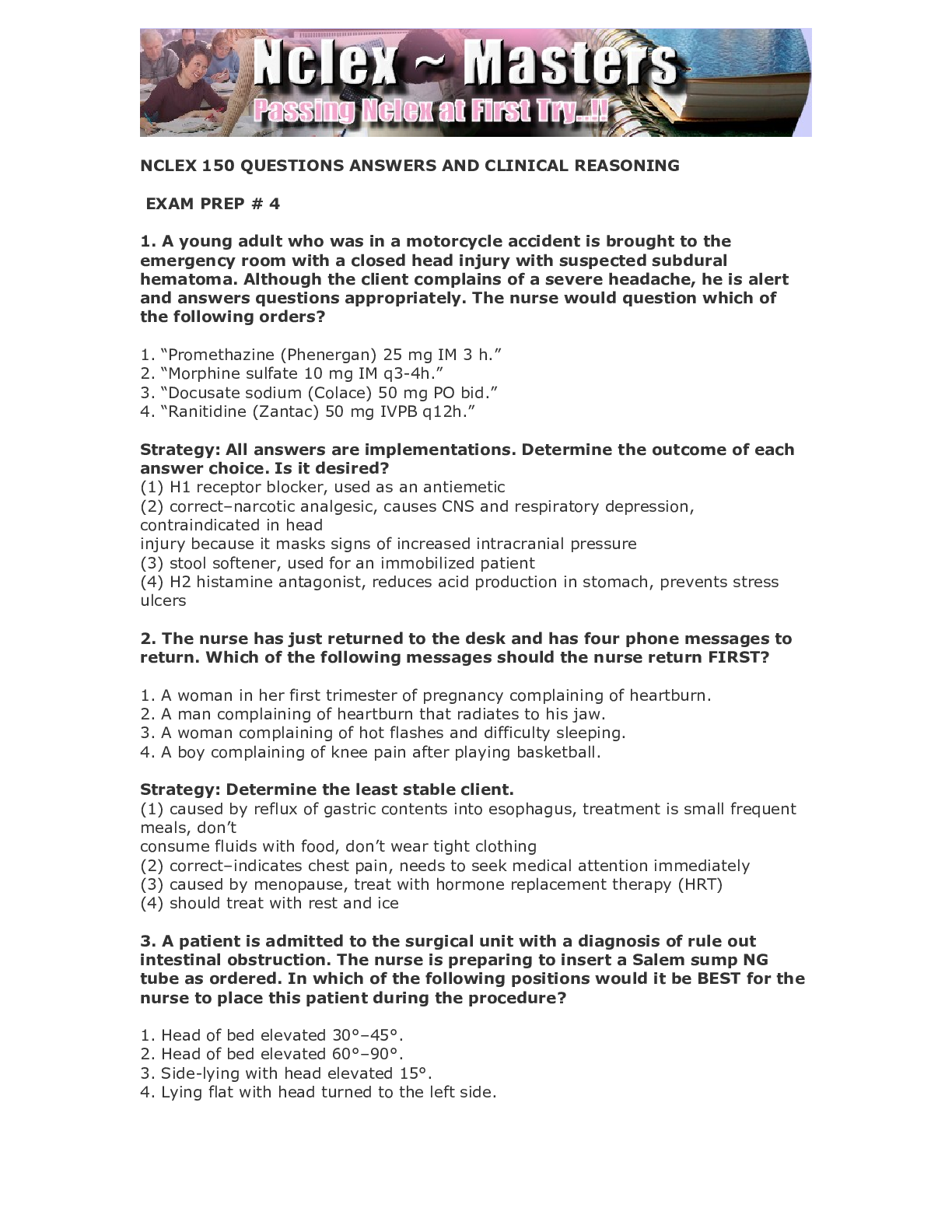*NURSING > QUESTIONS & ANSWERS > NREMT Exam_National Registry of Emergency Medical Technicians Exam. 150 Questions and Answers, 2022/ (All)
NREMT Exam_National Registry of Emergency Medical Technicians Exam. 150 Questions and Answers, 2022/2023 update, GRADED A
Document Content and Description Below
150 NREMT Exam Questions and Answers Which of the following is an example of an unsafe scene for an EMT-Basic to enter? A. Fifty-four-year old male with difficulty breathing B. Twenty-three-year o... ld female with abdominal pain C. Eighteen-year old adolescent with a gunshot wound to the chest D. Four-year old child with leg pain >>>>C. Eighteen-year old adolescent with a gunshot wound to the chest Reason: Any dispatch to a call with violence involved, such as a gunshot wound, must be secured by police prior to EMS involvement. The other calls do not give any inidication of being unsafe. The arterioles connect the _________ and the capillaries. A. Veins B. Venules C. Arteries D. Vena cavae >>>>C. Arteries Reason: The path of blood flow goes from the heart to the aorta to the arteries to the arterioles to the capillaries to the venules to the veins to the vena cavae to the heart. Which of the following patients is at greatest risk for hypothermia? A. Thirty-year old firefighter B. Twelve-year old skier C. Forty-five year old EMT D. Seventy-year old librarian >>>>D. Seventy-year old librarian Reason: The very young and very old are greater rsk for hypothermia The zygomatic bones are located in the A. Chest B. Lower leg C. Back D. Face >>>>D. Face Reason: The zygomatic bones are the cheekbones Which of the following federal laws was created to prevent "patients dumping" and the practice of denying treatment to patients with no insurance?A. Emergency Medical Treatment and Active Labor Act (EMTALA) B. The White Paper Act C. Health Insurance Portability and Accountability Act (HIPAA) D. The Medical Practice Act of 1988 >>>>A. Emergency Medical Treatment and Active Labor Act (EMTALA) Reason: The EMTALA was enacted by Congress in 1986 to ensure public access to emergency services regardless of their ability to pay. This act was also created to prevent hospitals from dumping their patients on other hospitals because of the patient's financial status. The White Paper (A) was not an act, but was a paper published in 1966 addressing the inadequacy of pre-hospital emergency medical care. The Health Insurance Portability and Accountability Act (HIPAA) (C) was created to protect the provacy of healthcare information. There is no such act as the Medical Practice Act of 1988 (D). When using air transport, the EMT-Basic should approach a helicopter A. From the uphill side B. From the rear C. Only when instructed by a helicopter crew member D. Under no circumstances, but instead allow the crew to come to them >>>>C. Only when instructed by a helicopter crew member Reason: Helicopters are dangerous vechicles, and safety rules include never approaching from the uphill side because of the danger of the rotors, or from the rear because of the tail rotor. In addition, EMT-Basics should never approach until instructed by a helicopter crew member so that the patient loading can be coordinated safely. Not approaching the helicopter at all may be impractical due to patient care concerns. Which of the following should be noted as insignificant in conducting the patient assessment? A. Medication bottles B. Comments of bystanders and family members C. Physical condition of the patient D. Patient's medical insurance >>>>D. Patient's medical insurance Reason: (A), (B), and (C) are all significant in conducting patient assessment. A patient's medical insurance is not a consideration in treating emergency patients. Which of the following is NOT a component of the Glasgow Coma Scale? A. Eye opening B. Verbal response C. Motor responseD. Tactile sensatory response >>>>D. Tactile sensatory response Reason: (A), (B), and (C) are all components of the Glasgow Coma Scale You have an EMT student riding with you one day. The student is studying for an upcoming test and cannot remember a legal term. The student knows that you must have four elements in order to prove this type of claim. The student knows that the four elements are duty, breach of duty, proximate cause, and harm caused. What term is the EMT student studying? A. Abandonment B. Simple negligence C. Gross negligence D. Malpractice >>>>B. Simple negligence Reason: In order to prove simple (also called ordinary) negligence, there must be four elements; duty, breach of duty, proximate cause, and harm caused The head is _________ to the chest. A. Inferior B. Anterior C. Superior D. Posterior >>>>C. Superior Reason: Superior refers to an upper region, so the head is considered superior to the chest, while the chest would be considered inferior to the head. Anterior is the front, and posterior is the back What does the "A" stand for in DCAP-BTLS A. Anascoria B. Arterial bleeding C. Alert response D. Abrasions >>>>D. Abrasions Reason: The "A" in DCAP-BTLS stands for abrasions There are ________ vertebrae in the lumbar section A. 5 B. 12 C. 14 D. 19 >>>>A. 5Reason: The cervical section of the spine has 7 vertebrae, the thoracic 12, the lumber 5, the sacral 5, and the coccyx 4 Signs and symptoms of post-traumatic stress disorder (PTSD) include the following EXCEPT A. Loss of sexual desire B. Loss of appetite C. Loss of interest in work D. Loss of spontaneity >>>>D. Loss of spontaneity Reason: Loss of spontaneity is not a characterisitc symptom of the post-traumatic stress disorder. The other answers are all symptoms of PTSD, and if they last longer than a few days, the EMT-Basic should be referred for professional help The letter "G" in the APGAR score stands for A. Grating B. Grimace C. Guarding D. Gurgling >>>>B. Grimace Reason: The baby's ability to make facial expressions is indicative of its ability to function in the outside world. Grating refers to rubbing of two organs together, guarding is when one protects a portion of the body with one's hands, and gurgling is the sound one makes when there is fluid in the oropharynx. None of these are indicators in the APGAR score You are dispatched to an auto accident on a local city street. You respond priority and arrive on scene with suitable precautions. The police are on scene. There is one victim, a woman seated in the car. Her car backed into another car as she was pulling out of her driveway at low speed. As you approach the car, she advises you that she is 36 weeks pregnant with her first child. She advises you that she has no injuries and no hemorrhaging and is not in any pain; however, she wishes to be checked out at the hospital. In what position should she be transported? A. Trendelenburg B. Fowler C. Left lateral recumbent D. Right lateral recumbent >>>>C. Left lateral recumbent Reason: Unless contraindicated by some other condition, women in their third trimester of pregnancy should be transported on their left side to prevent the weight of the child from compressing their vena cavae and causing circulatory problems, which could lead to impairment of consciousness and other complications. Trendelenburg is when the legs are elevated to help combat hypotension, and Fowler position is seated uprightYou respond to a 18-year old male patient who is threatening suicide. The fire department states that before you arrived, the patient told them that he wanted to kill himself. Now, the patient is telling you that he does not want to hurt himself and he just wants to be left alone. Which of the following is the most appropriate treatment? A. Explain the risks of staying at home with suicidal thoughts, and then have the patient sign a refusal form if he appears mentally competent. B. Inform the patient that because he told the fire department that he wants to hurt himself that he will have to go to the hospital. Have the police department assist you with ensuring that the patient is transported to the hospital. C. Find out if the patient can make an appointment with his personal doctor, and then confirm that he has does have an appointment before you clear the scene and return to the station. D. Since the patient did not tell you personally that he wants to kill himself, you must allow him to make his own decisions. Explain to him that he needs to get mental health assistance. >>>>B. Inform the patient that because he told the fire department that he wants to hurt himself that he will have to go to the hospital. Have the police department assist you with ensuring that the patient is transported to the hospital. Reason: Because the patient has already expressed the desire to harm himself to a public safety official, the patient must be evaluated by a physician. If the patient refuses to go with you, the police may have to place the patient in protective custody to have him transported to the hospital You respond to call for a female acting strangely. You respond nonpriority and are met by the police, who request you transport the patient to a hospital for a psychological evaluation. The patient is a twenty-year old female who is ballet dancing in the supermarket, bowling, and throwing kisses to an imaginary dancing partner, Rudolf Nureyev. You should next A. Pretend to shake Mr. Nureyev's hand B. Wrap your arms around the patient and force her to the stretcher C. Gently explain to her that there is no Mr. Nureyev dancing with her D. Tackle the patient and assist the police in handcuffing her hands behind her back >>>>C. Gently explain to her that there is no Mr. Nureyev dancing with her Reason: The patient is not exhibiting a behavior that requires you to respond with overly aggressive technique, such as tackling her or wrestling her to the stretcher. She is having delusions, and it is not wise to give these delusions credence by acknowledging them, such as by shaking Mr. Nureyev's hand. She might protest when you tell her that Mr. Nureyev is not right there dancing with her, but your confidence and gently demeanor will more often than not win her over to doing what you would like her to do A neonate will normally have ______ pulse rates and respiratory rates than an infantA. Higher B. Lower C. More irregular D. Less irregular >>>>A. Higher Reason: Neonates have higher pulse rates and respiratory rates than infants. There is no change in regularity between neonates and infants Most EMTs are injured at which of the following types of calls? A. Domestic violence calls B. Motor vehicle accidents C. Workplace injury calls D. In-station accidents >>>>B. Motor vehicle accidents Reason: Most EMT's are injured while treating injured patients at motor vehicle accidents and thus should be more alert to the dangers posed by being on the streets and highways. The other situations also present dangers of which the EMT must be aware, but the MVA is the leading cause of injury . Veins are blood vessels that carry deoxygenated blood ______ the heart A. Into B. Away from C. Toward D. From the lungs to >>>>C. Toward Reason: Veins carry blood toward the heart. The vessels that carry blood away from the heart are the arteries Which of the following is NOT a type of muscle? A. Voluntary B. Involuntary C. Cardiac D. Regulatory >>>>D. Regulatory Reason: The three types of muscles are voluntary, involuntary, and cardiac. There is no such thing as a regulatory muscle Which of the following is NOT a component of the SAMPLE history? A. Signs and symptoms B. Allergies C. Medications D. Pulse rate >>>>D. Pulse rateReason: SAMPLE stands for Signs and symptoms, Allergies, Medications, Pertinent past history, Last oral intake, and Events leading up to this situation. Pulse rate is a vital sign When should EMS communication equipment be checked? A. Daily B. Monthly C. Weekly D. At the start of every shift >>>>D. At the start of every shift Reason: Communications equipment should be checked at the start of each shift. No self-respecting EMT-Basic would like to find out two hours into the shift that his radio was not working and that calls were missed The first thing to be considered when arriving on scene of an emergency call is A. Scene safety B. Universal precautions C. Airway D. Breathing >>>>A. Scene safety Reason: Before anything else is done, the EMT-Basic must be certain that the scene is safe to operate in. Universal precautions should already be in place prior to arrival on scene What is the legal degree of intoxication for a person to be judged incompetent to refuse medical care? A. .08 percent B. .1 percent C. 1 percent D. There is no legal limit >>>>D. There is no legal limit Reason: There is no legal limit for declaring that a person is so impaired as to be judged incompetent. It is a judgement call on part of the EMT-Basic Once you have determined that the scene is safe and you are wearing the proper universal precautions, the next thing to be checked is A. Airway B. Breathing C. Circulation D. Level of consciousness >>>>D. Level of consciousnessReason: Once the scene is determined to be safe and the EMT-Basic is wearing proper precautions, the EMT-Basic must assess the level of consciousness Which of the following is NOT a level of consciousness? A. Alert B. Conscious C. Active D. Oriented >>>>C. Active Reason: Answers (A), (B), and (D) are all descriptions of levels of consciousness Perfusion in patient assessment refers to the A. Amount of fluid in the lungs B. Amount of oxygen in the hemoglobin C. Amount of urine in the bladder D. Amount of blood in the heart >>>>B. Amount of oxygen in the hemoglobin Reason: Perfusion refers to the percentage of oxygen that a red blood cell can carry to the cells and is measured by the use of the pulse oximeter. This is a vital sign for determining how efficiently the lungs are transferring oxygen to the red blood cells and how well the heart is pumping those cells throughout the body. Basics EMTs do not have the diagnostic capabilities to determine the other answers. Your patient has a core body temp of 35 degrees Celsius. This temp indicated what stage of hypothermia? A. Mild B. Moderate C. Severe D. Irreversible >>>>A. Mild *multiply by 1.8 and then add 32* Reason: A core body temperature of 33 degrees Celsius indicates mild hypothermia. A temperature of 28-32 degrees Celsius indicates moderate hypothermia, and a temperature less than 28 degrees Celsius indicates severe hypothermia. Irreversible hypothermia (D) is not considered a stage of hypothermia. You are dispatched to a residence for a man down. You respond priority and arrive on scene wearing suitable precautions. The scene is safe. You enter the bedroom, and the patient's wife advises you that he is being treated for lung cancer and is undergoing chemotherapy. The patient presents on the primary assessment as unresponsive with no gag reflex. His airway is open, he is breathing spontaneously at a rate of 12, and he has a weak thready pulse rate of 100. You insert an oropharyngeal airway andadminister supplemental oxygen via a nonrebreather mask at a flow rate of 12 lpm. Your transport time to the nearest hospital emergency room is 30 minutes, but there is an ALS unit 15 minutes out. You should next A. Call for an ALS intercept B. Begin priority transport C. Administer .3 mg epinephrine subcutaneously D. Request an air transport >>>>A. Call for an ALS intercept Reason: This patient may benefit from an ALS intervention depending on his underlying medical problem. Since ALS is within half the time that it would take to get him to an emergency department, this would be the most correct solution. The administration of epinephrine (C) would be used only if the assessment gave some indication that his level of consciousness was due to an allergic reaction. The helicopter (D) is not really appropriate in this situation since the amount of time spent taking off and landing would delay arrival of the patient at the emergency department. The letter "Q" in the acronym OPQRST stands for A. Quantity B. Quality C. Quasi D. Quick >>>>B. Quality Reason: OPQRST stands for Onset, Provocation, Quality, Radiation, Severity, and Time. This question also reinforces the need to read the question carefully, since the words "quality" and "quantity" are very close. After the focused trauma assessment is completed on a trauma patient, the assessment should be rechecked every A. Two min B. Five min C. Ten min D. Fifteen min >>>>B. Five min Reason: Good patient assessment requires that vital signs and assessment observations be checked and tended every five min since patient condition can change very rapidly. Which of the following best describes an indirect force injury? A. When a force is applied to one region of the body but cause an injury to another region of the body B. When an object strikes a person and transfers all of its energy to the point of impact C. When a patient has a medical condition that causes weekend bones to fractureD. When a penetrating injury leads to a fracture or other musculoskeletal injury >>>>B. When an object strikes a person and transfers all of its energy to the point of impact Reason: Answers (A) and (C) describe a direct force injury. Answer (D) describes a pathological fracture In the mnemonic DCAP-BTLS, the letter "B" stands for A. Bruising B. Brittleness C. Burns D. Bradycardia >>>>C. Burns Reason: The mnemonic DCAP-BTLS is used in the focused assessment of a trauma patient and stands for Deformity, Contusions, Abrasions, Punctures, Burns, Tenderness, Lacerations, and Swelling. A patient viewed from the side is bisected by the A. Midaxillary line B. Midclavicular line C. Midsternal line D. Horizontal plane >>>>A. Midaxillary line Reason: The midaxillary line runs through the underarm of the patient, dividing the anterior plane from the posterior plane. You are dispatched to a man who has fallen from a garage roof. You respond priority and arrive on scene wearing suitable precautions. The scene is safe. The patient is a thirty-two year old male who is conscious, but confused as to events. You are holding stabilization while your partner completes the focused trauma assessment. Which device should be applied following the focused assessment of the head and neck? A. Halo traction device B. Har traction device C. Hale splint D. Cervical collar >>>>D. Cervical collar Reason: This is the type of question that challenges your knowledge. The tendency is to choose one of the "H" answers since the correct answer seems out of place, and there is such a thing as the hare traction splint. The Good Samaritan Act is a A. Religious doctrine B. Statue that minimizes liability for certain actsC. Good deed done by an EMT D. Play put on by EMTs to entertain children >>>>B. Statue that minimizes liability for certain acts Reason: The Good Samaritan Act was passed to encourage people to render aid by minimizing the liability for such acts While en route to the hospital with a critically ill patient, how often should you repeat vital signs as part of ongoing assessment? A. Every one min B. Every three min C. Every five min D. Every ten min >>>>C. Every five min Reason: While five min is the standard, vital signs should be retaken anytime there is any change in the patient's condition. Changes in the patient's condition will only be noted if the patient's ongoing assessment is constant and not just a predetermine interval The "U" in the mnemonic AVPU means A. Uniform B. Unequivocal C. Unknown D. Unresponsive >>>>D. Unresponsive Reason: AVPU stands for Alert, Verbal, Pain, Unresponsive, and is used to assign a level of consciousness to a patient. A patient who does not awaken when yelled at, and doesn't respond to a vigorous rubbing of his sternum is considered unresponsive. Which of the following should never be given over the two-way radio system? A. The location of a call B. The nature of a call C. The patient's name D. The EMT's name >>>>C. The patient's name Reason: Patient confidentially laws mandate that the patient's name and specific medical information be kept confidential. Broadcasting a patient's name over the radio, which is monitored, would be a violation of this confidentiality. (A) and (B) would be important information in responding to a call. Which of the following is NOT a required part of a prehospital care report? A. Patient's nameB. Patient's date of birth C. Patient's gender D. Patient's medical insurance information >>>>D. Patient's medical insurance information Reason: While some reports do have spaces for medical insurance information for use by billing services, this information is not required for the patient care report. You are dispatched to the local high school for an eye injury. You respond priority and arrive on scene is safe, and you are wearing suitable precautions. You are directed to the nurse's office, where you find a sixteen-year old male with a pencil stuck in his left eye. All vital signs are normal, and there is no other injury. You should dress and bandage A. His left eye B. Both eyes C. His entire upper head D. A dressing is not indicated >>>>B. Both eyes Reason: When bandaging an eye injury, you must cover both eyes to prevent the sympathetic movement of the uninjured eye from causing further injury to the injured eye. In the absence of other injuries, there is no need to bandage the entire upper head Which of the following situations does NOT have to be reported by EMT-Basics if they become aware of them? A. Child abuse B. Sexual abuse C. Elderly abuse D. Abuse of the 911 system >>>>D. Abuse of the 911 system Reason: All states mandate reporting by medical providers to the appropriate state agency if they become aware of child abuse. Some states also require reporting of sexual abuse, elder abuse, and spousal abuse, but this not yet universal. Mandatory reporting of abuse of 911 system is not required, but may be done at the option of the EMT. When is the umbilical cord cut? A. Immediately after the baby is delivered B. When it ceases pulsing C. When the placenta is delivered D. At the hospital >>>>B. When it ceases pulsing Reason: Once the cord ceases pulsing and the baby is breathing on his or her own, it is safe to cut the cord. If the cord is cut before the pulsing has ceased, there is danger ofthe mother exsanguinating (bleeding). In waiting until the placenta is delivered, there is no increased danger to the mother or neonate, nor would waiting to arrive at the hospital be a problem. However, in order to properly treat the neonate, it would be easier to have him or her separated from the placenta. Which of the following is NOT a sign or symptom of hypovolemic shock? A. Dropping blood pressure B. Excessive thirst C. Tachypnea D. Hypertension >>>>D. Hypertension Reason: Dropping blood pressure (A), excessive thirst (B) and tachypnea (C) are all symptoms of hypovolemic shock, along with tachycardia, or fast heart rate. Hypertension (D) is not seen in shock. A competent patient may refuse which of the following procedures? A. Cervical stabilization with a cervical collar B. Spinal immobilization with a spine board C. Intravenous fluid administration D. All of the above >>>>D. All of the above Reason: A competent and conscious patient may refuse any medical procedure or transport Which of the following oxygen delivery devices normally provides between 24-44 percent oxygen when attached to supplemental oxygen? A. Nasal cannula B. Simple face mask C. Nonrebreather mask D. Bag-valve mask >>>>A. Nasal cannula Reason: The nasal cannula provides between 24-44 percent oxygen. The simple face mask (b) provides 40-60 percent oxygen. The nonrebreather mask (C) provides 90-100 percent oxygen, and the bag-valve mask (D) provides nearly 100 percent oxygen. SIDS normally occurs between the ages of A. 0 and 1 B. 1 and 3 C. 2 and 3 D. 3 and 4 >>>>A. 0 a [Show More]
Last updated: 9 months ago
Preview 1 out of 41 pages
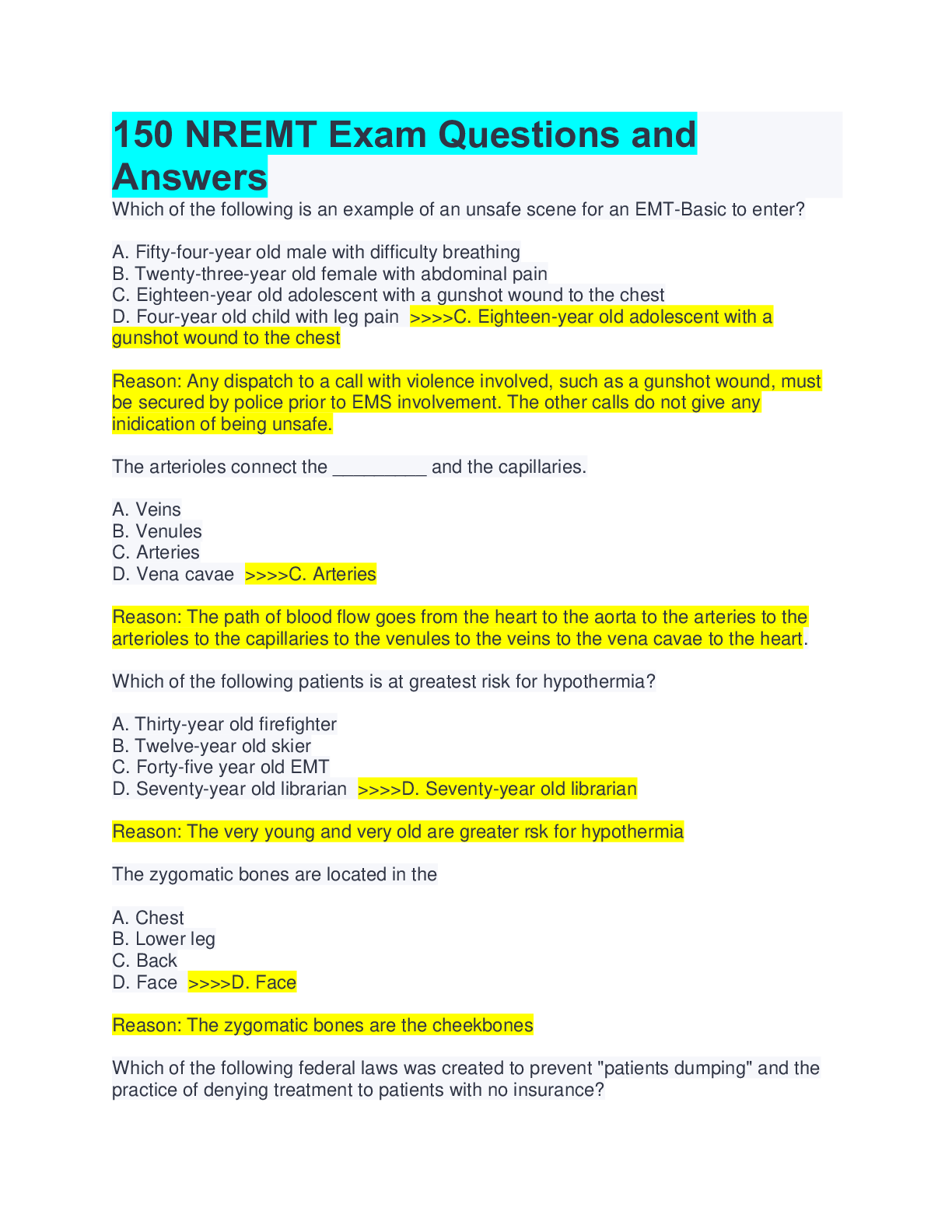
Reviews( 0 )
Document information
Connected school, study & course
About the document
Uploaded On
Sep 19, 2022
Number of pages
41
Written in
Additional information
This document has been written for:
Uploaded
Sep 19, 2022
Downloads
3
Views
1052




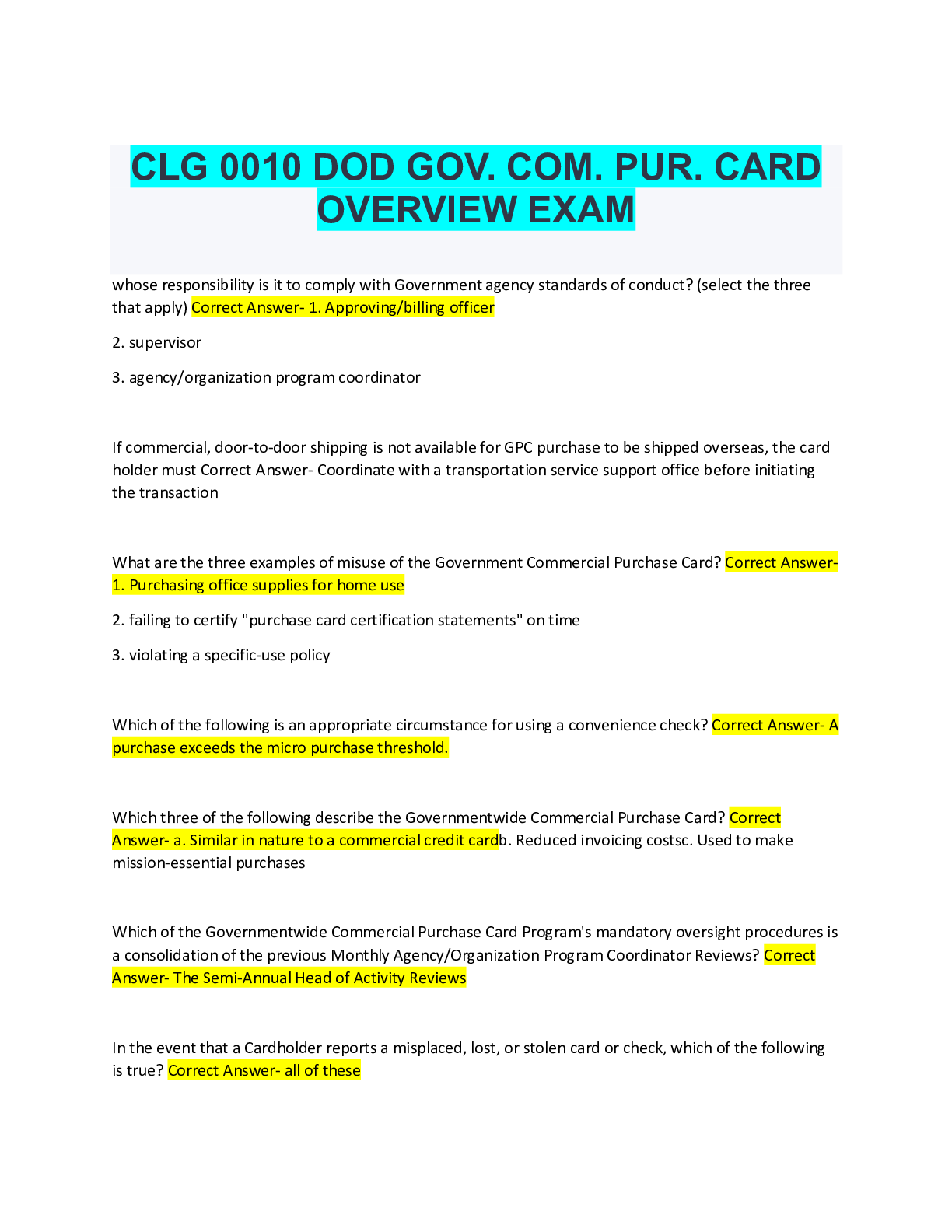


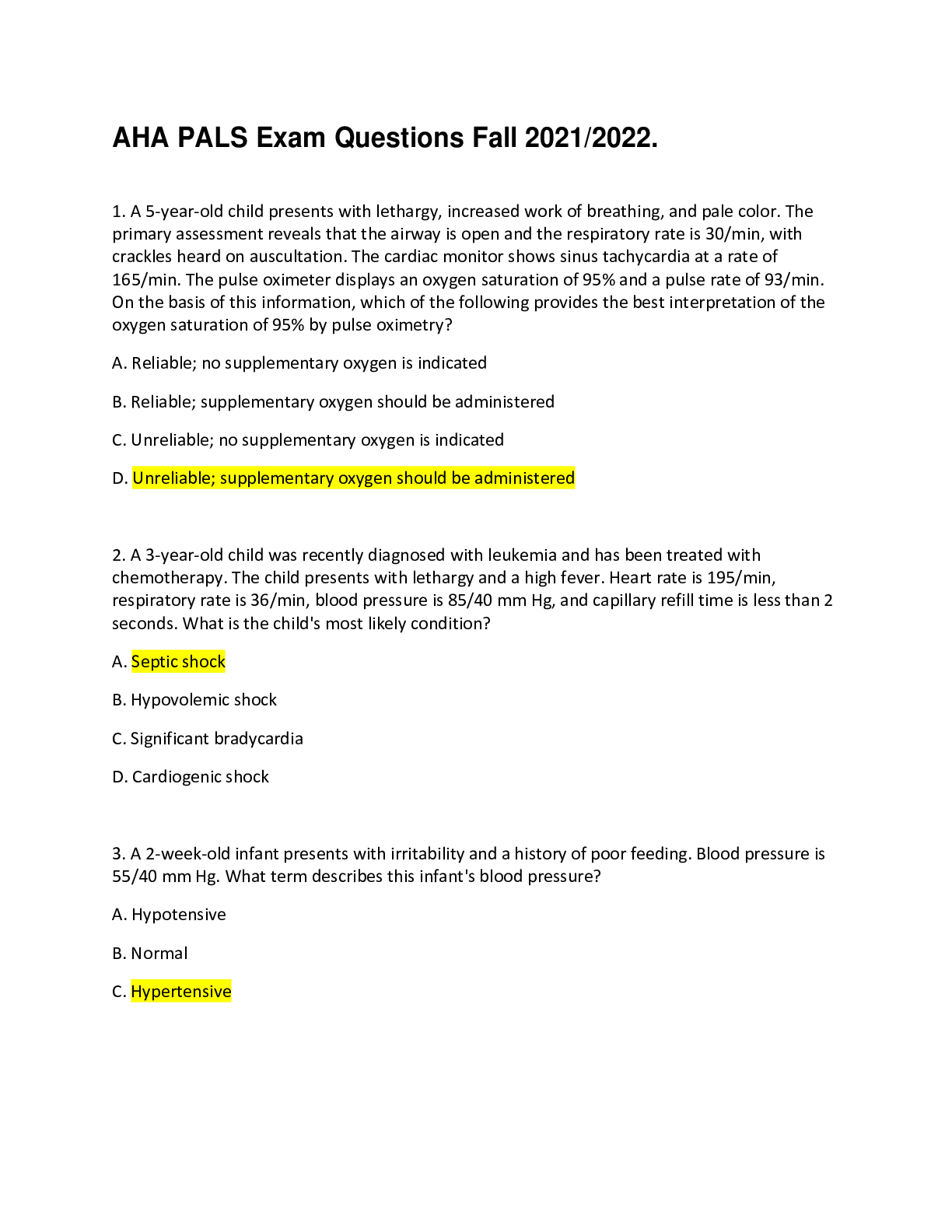

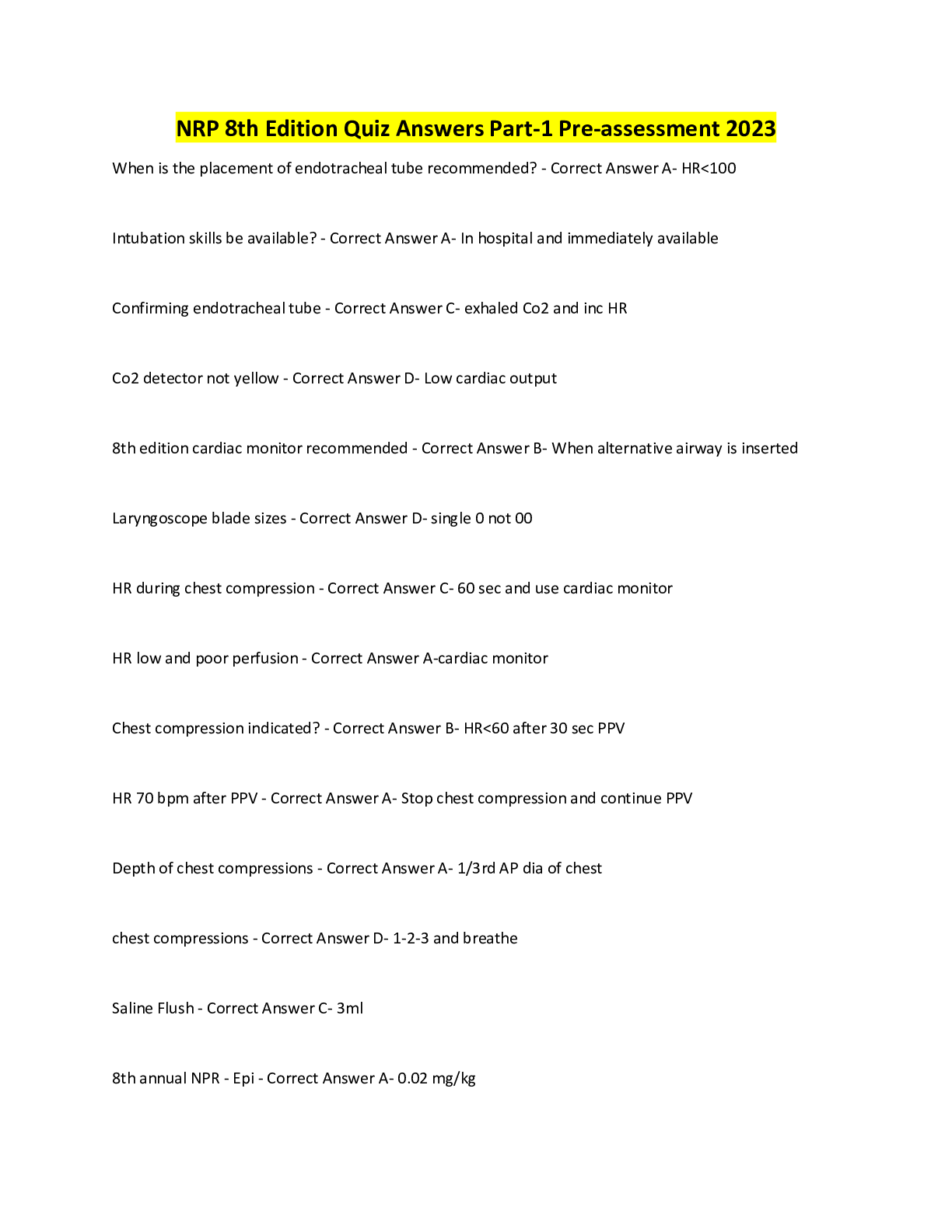

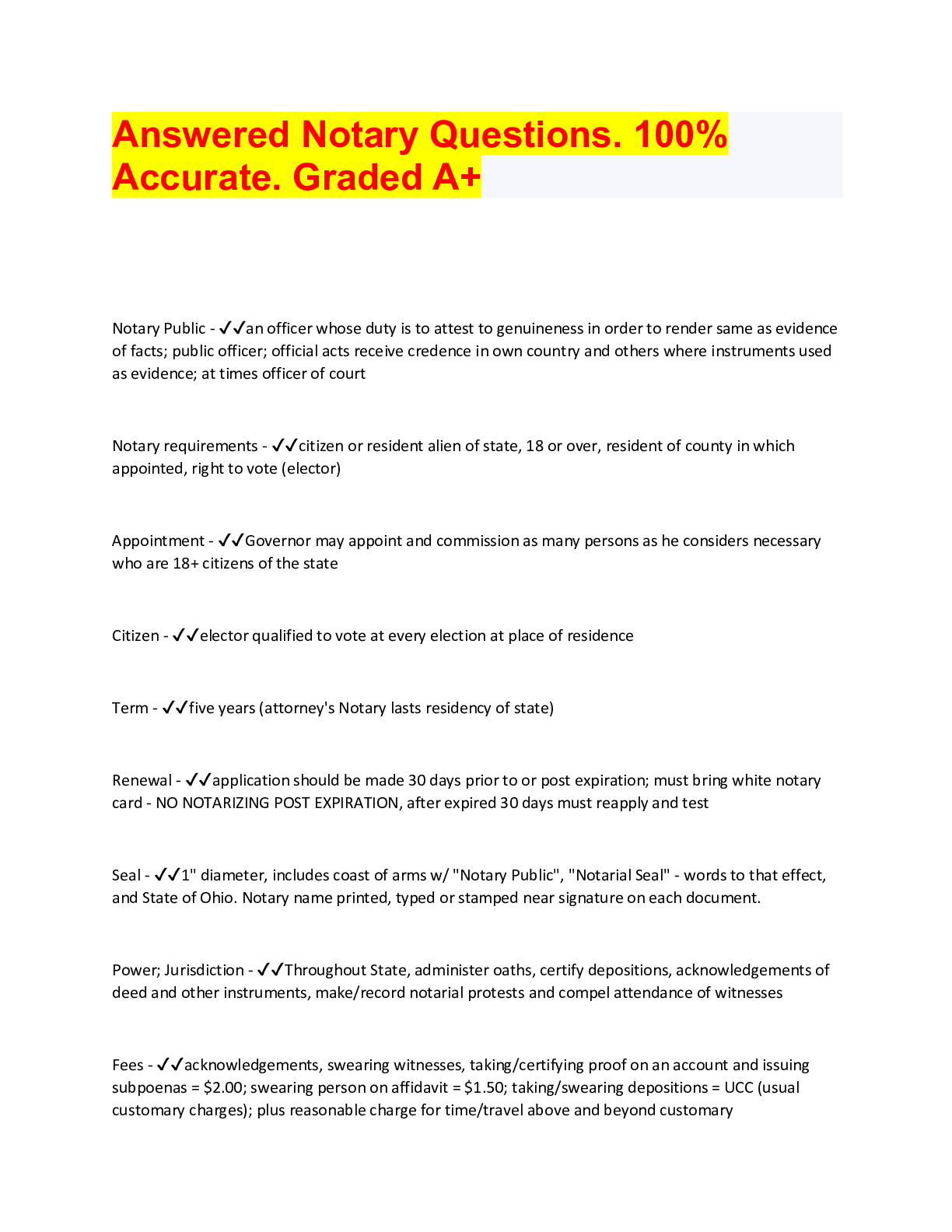

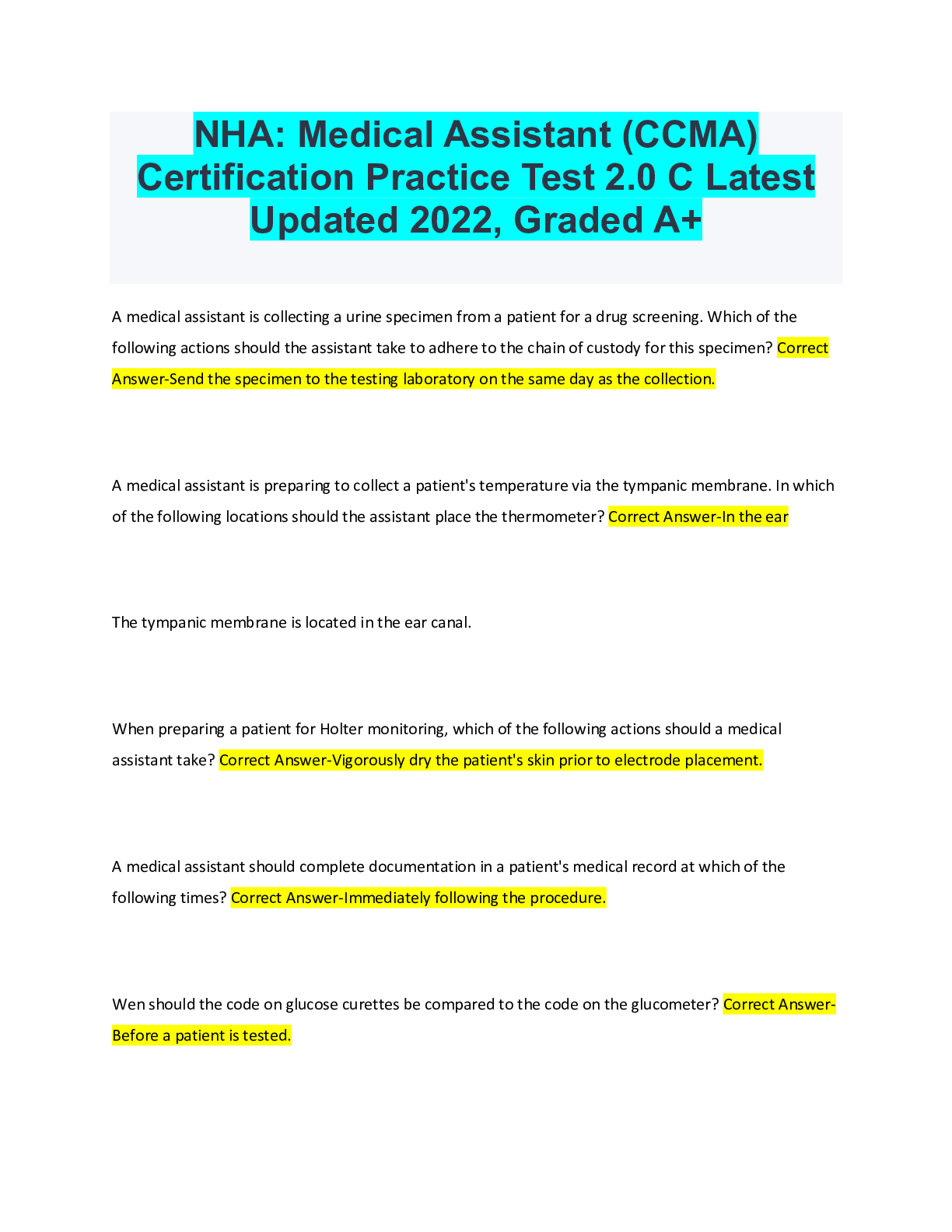
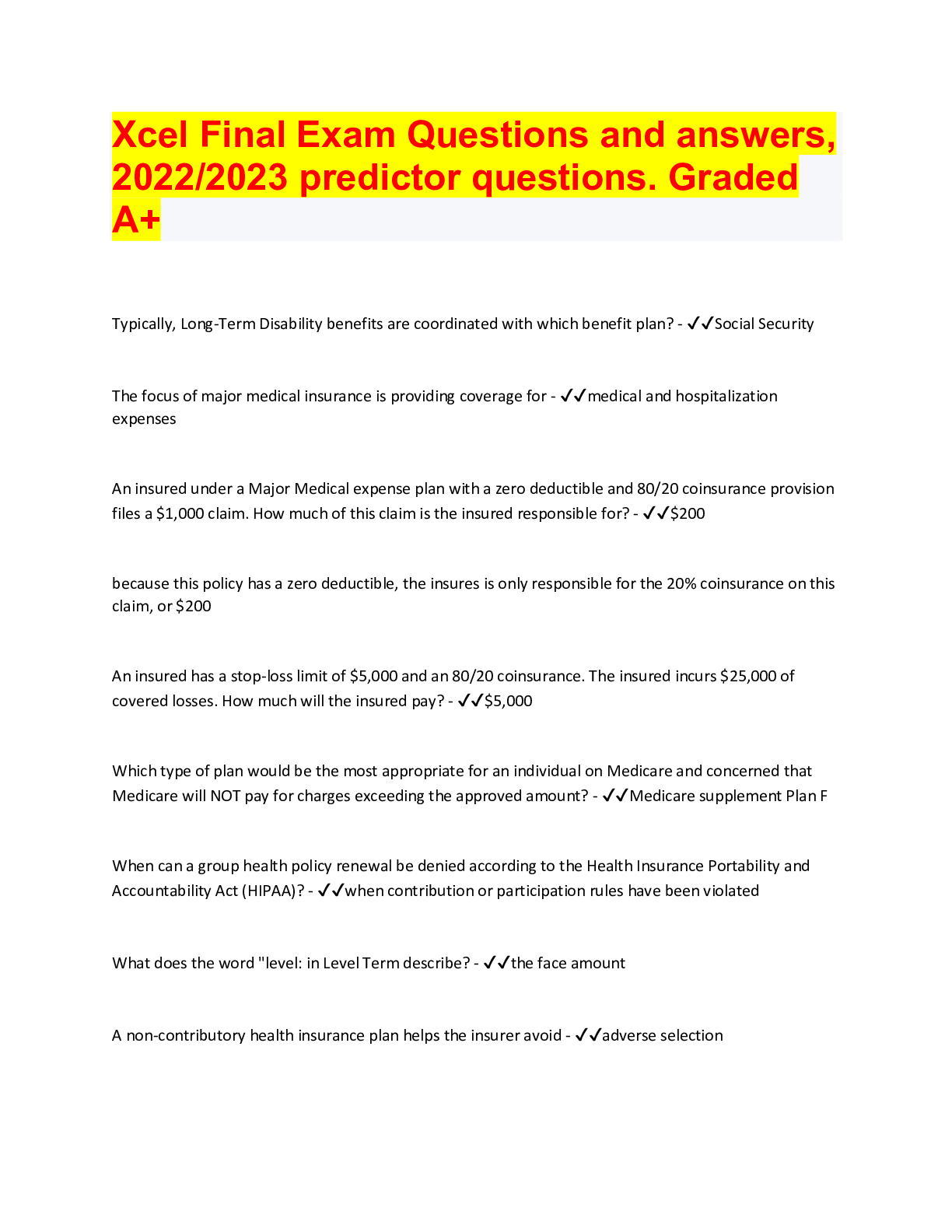
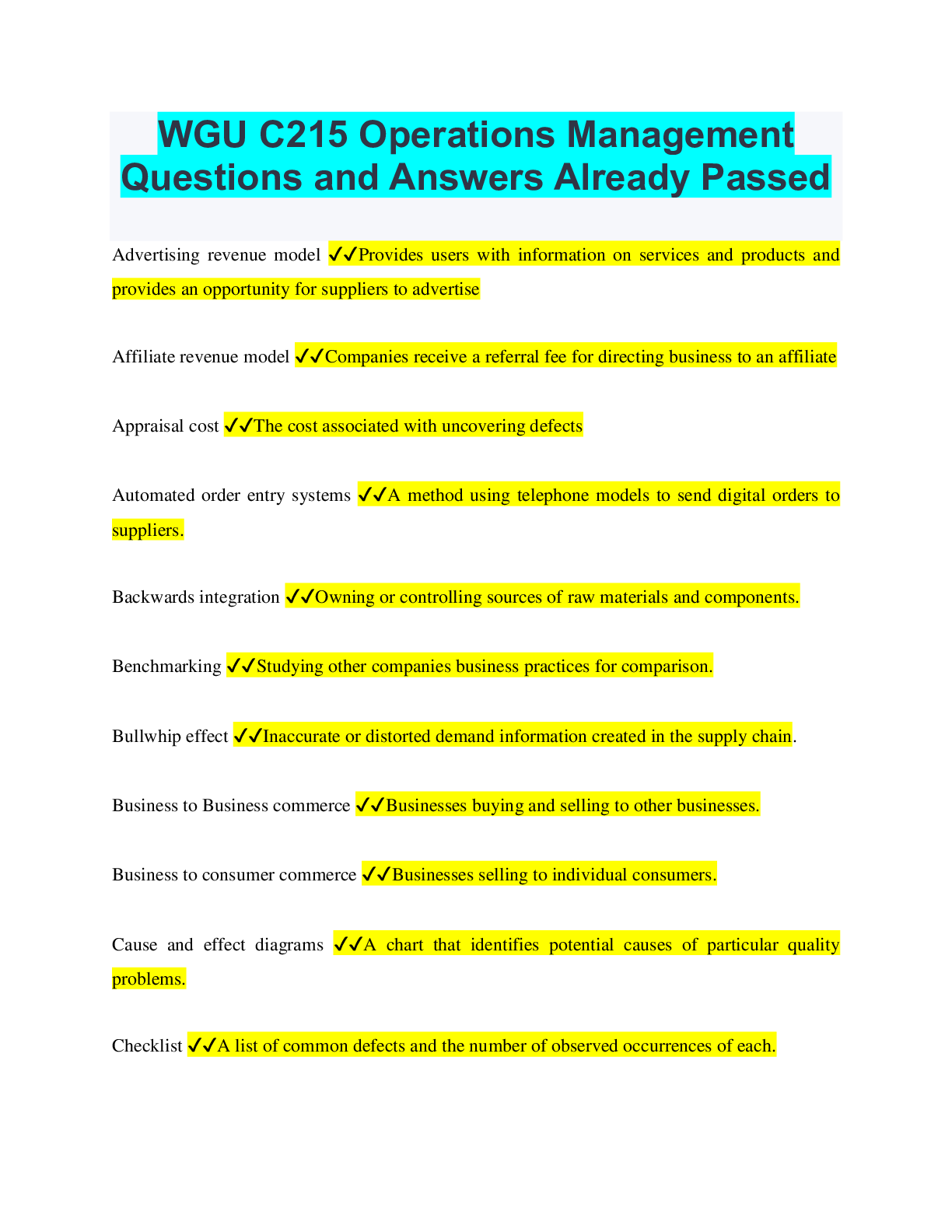
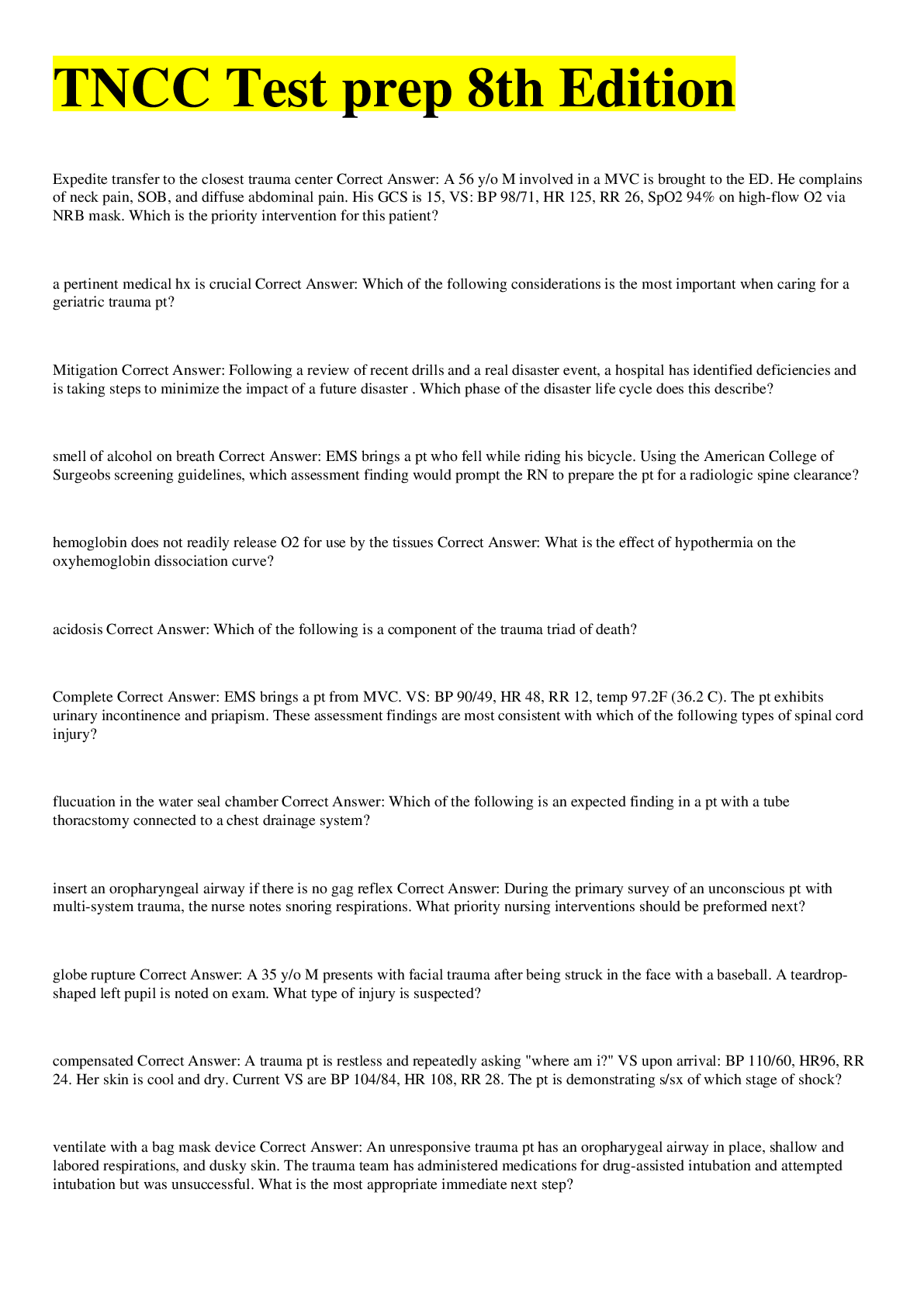
.png)
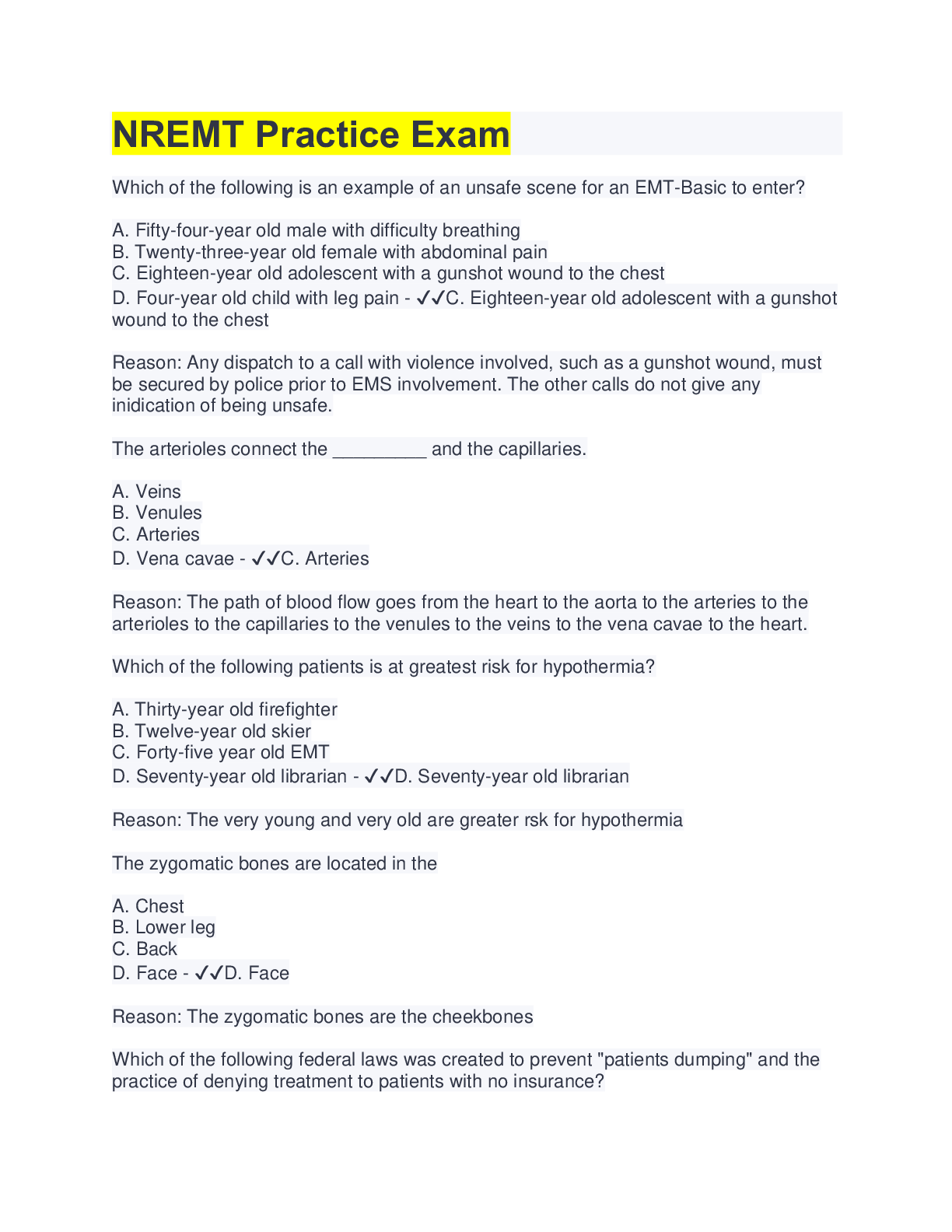

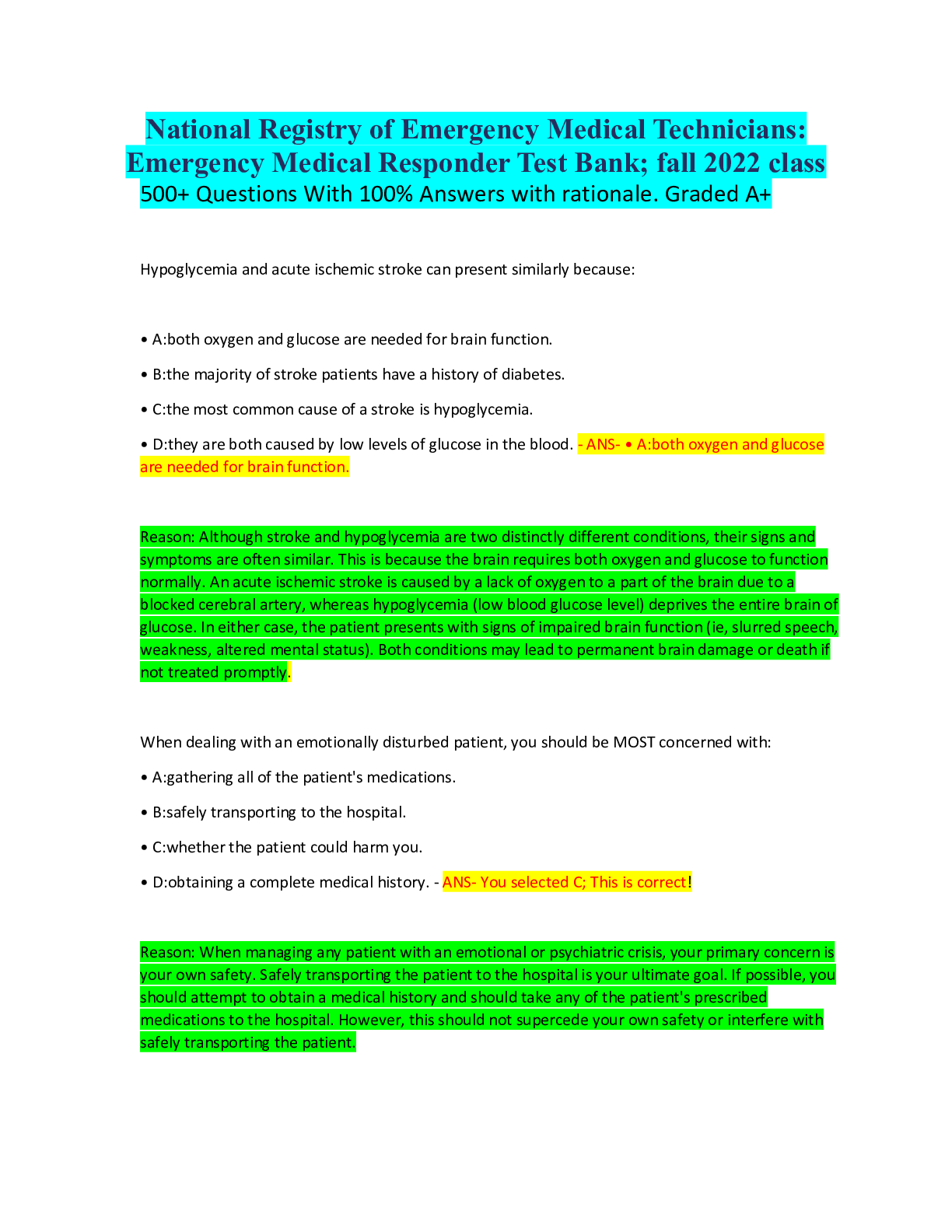
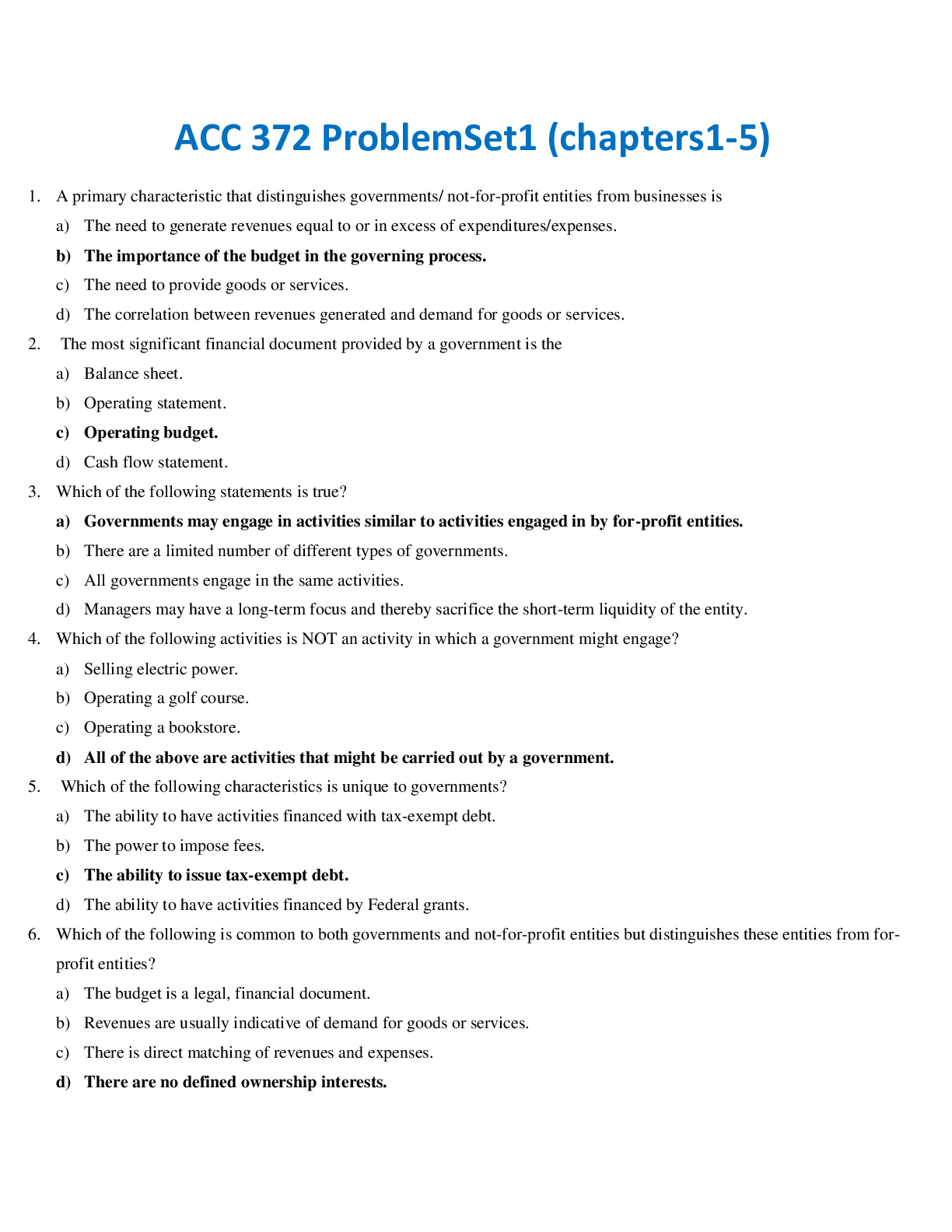
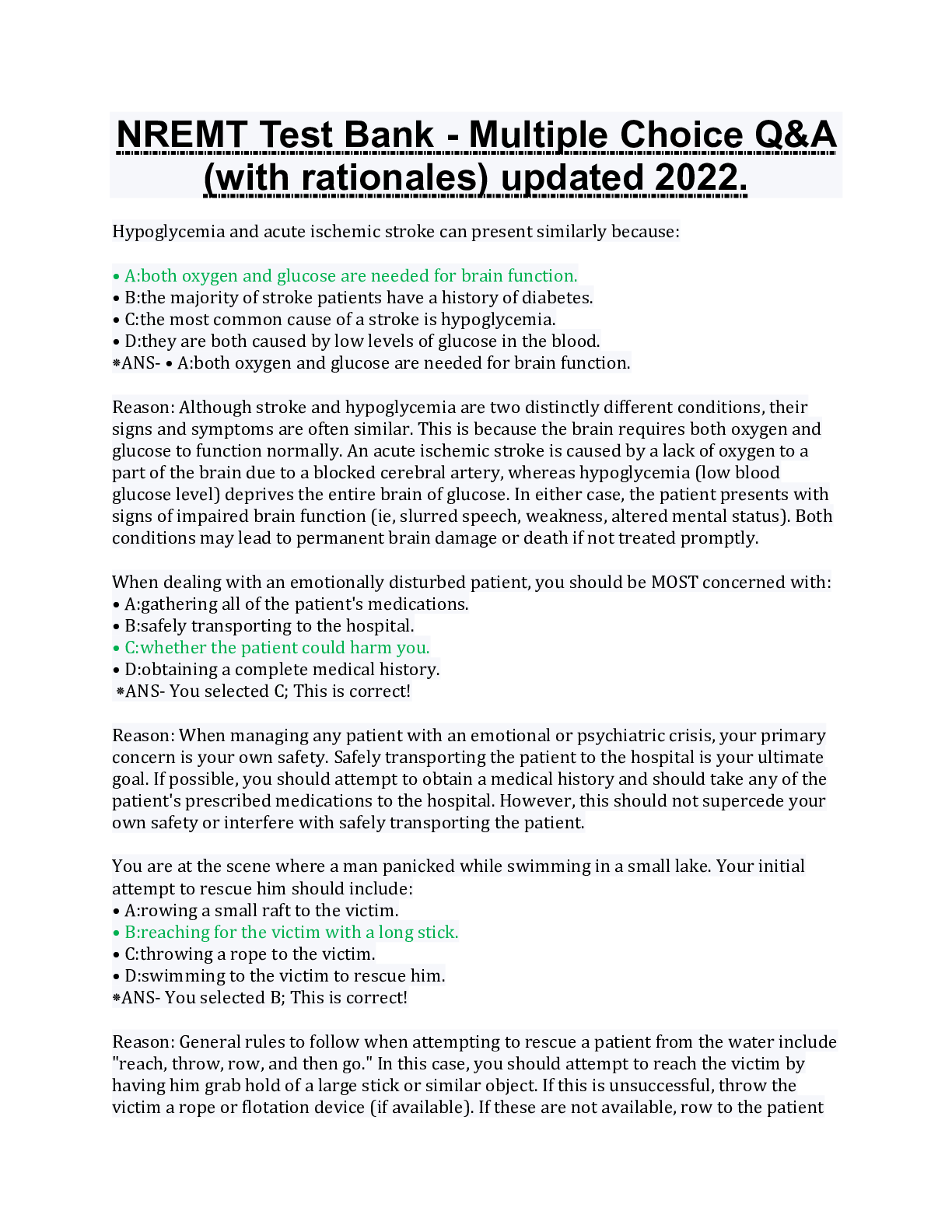
.png)
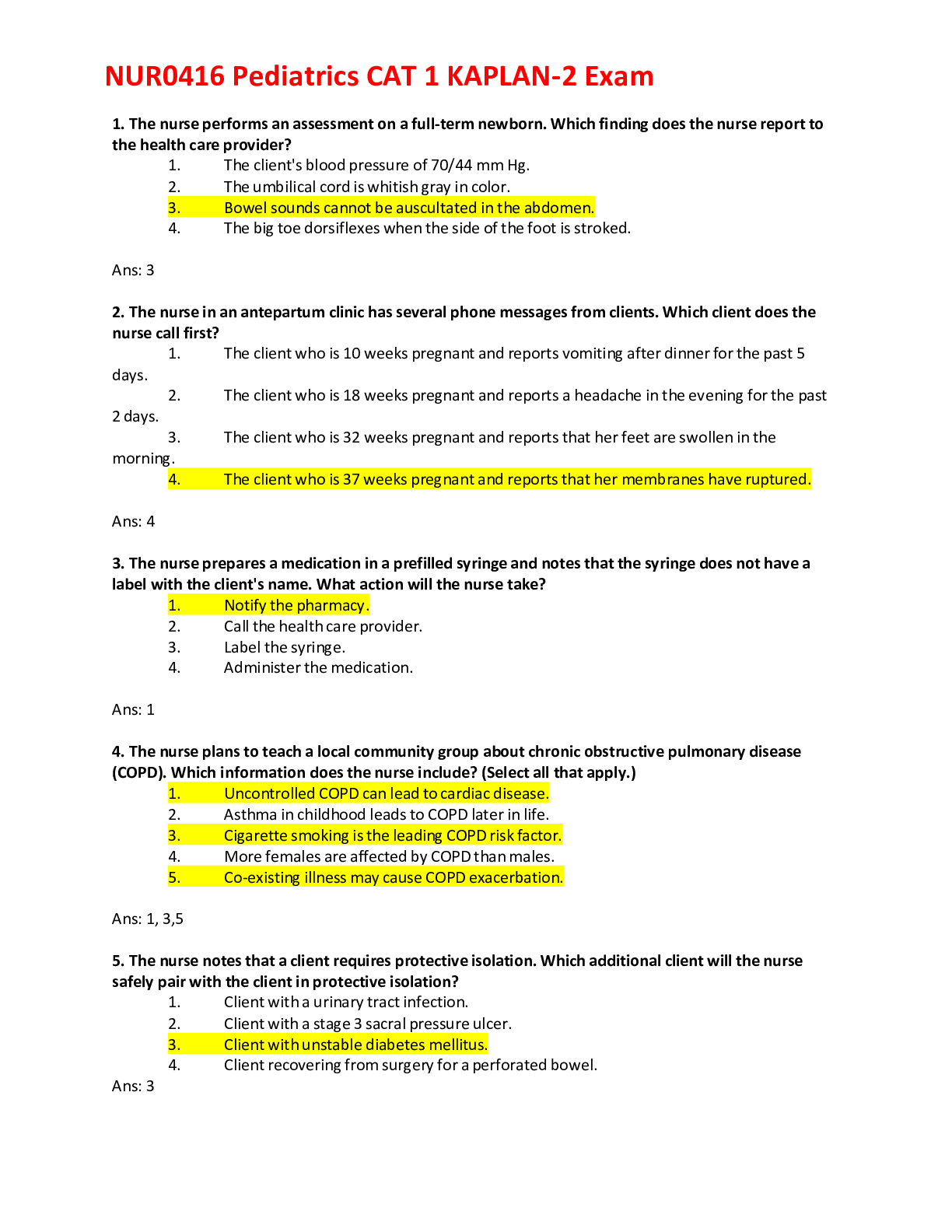
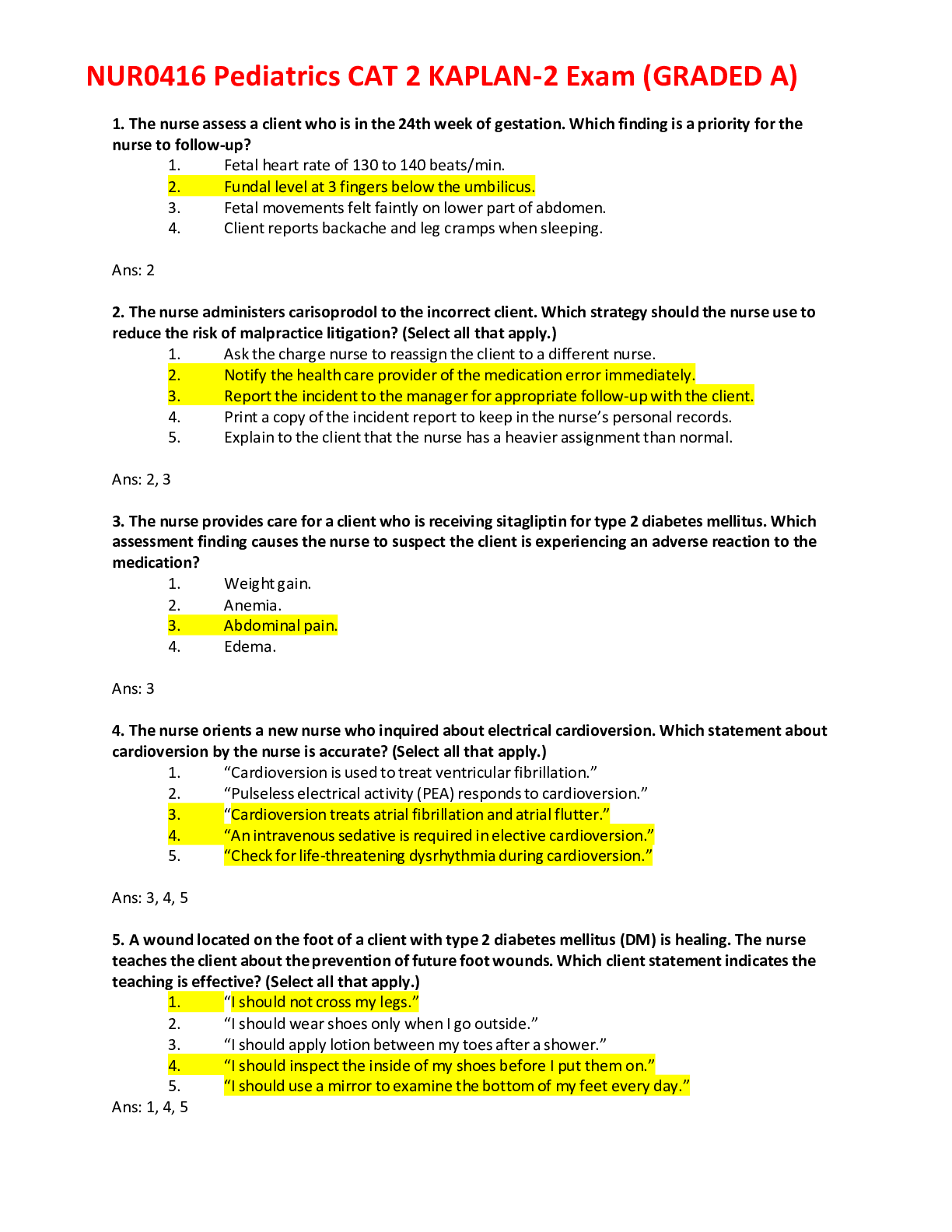
 Complete 150 Questions and Answers Provided Exam Study Guide.png)
 Complete 150 Questions and Answers Provided Exam Study Guide.png)
